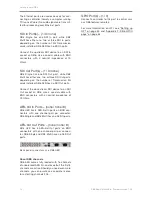
DB6: An introduction
10
DB6 Single / Multi / AES – Firmware version 1.30
DB6 Single vs. DB6 Multi
DB6 is available in three different hardware ver-
sions:
DB6 Single
,
DB6 Multi
and
DB6 AES.
DB6 Single
handles one SD/HD/3G stream,
making it the perfect choice e.g. for local broad-
casters or as an intelligent loudness manage-
ment tool in an OB van. DB6 single cannot be
expanded to handle more audio streams.
DB6 Multi
comes with the ability to process one
stream right out of the box, but users can install
one or two additional
3G Transmission
dual-
engine cards.
DB6 AES
gives you up to 16 channels of unbal-
anced AES I/O on BNC connectors. Depending
on your integrated transmission system, you may
prefer to pass your entire SDI signal through a
loudness management system, or you may pre-
fer to route only the audio signal through an in-
sert point. With DB6 AES, you get the opportu-
nity to choose the latter scenario as well.
3G Transmission cards
Each 3G Transmission card…
– can
process one SDI audio stream
– holds
two multichannel processors
– is capable of running…
–
two LM6 Loudness Radar Meters
as well as
–
two LoudnessWizard™
algorithms simul-
taneously.
Accordingly, a DB6 Multi with two 3G Trans-
mission cards can handle
three independent
streams
– making it the perfect high-density
solution for any TV station in need of processing
multiple streams simultaneously.
Extensibility is the only relevant difference
between DB6 single and DB6 Multi.
Both ver-
sions feature the same high-quality hardware as
well as the same powerful software algorithms.
Instructions on upgrading a base DB6 Multi
with one or two Transmission 3G cards are
not part of this manual.
They are provided in
a separate document that comes with the 3G
Transmission card.
SDI: The Serial Digital Interface
With regards to inputs and outputs, DB6 is
based on the Serial digital interface (SDI) – a
family of audio and video interfaces standard-
ized by the Society of Motion Picture and Televi-
sion Engineers (SMPTE).
An SDI signal may contain up to sixteen audio
channels (8 pairs) at 48 kHz sample rate and 24
bit resolution. We assume that you have a good
working knowledge of SDI. The standard as such
is not discussed in this manual.
DB6 AES
For many years, TC Electronic has focused on
developing highly intelligent clocking solutions.
The DB6 features one of the most complex and
intelligent technologies we have ever made. It is
based on the TC developed DICE™ core with its
JET™ Technology, which has been further re-
fined to deliver important features specifically for
broadcast use.
– DB6 locks really fast and artefact-free to clock
sources.
– It sends as good an audio signal as possible
through at all times.
– If the source is lost, DB6 keeps on running at
the “last good sync source rate”.
– DB6 keeps outgoing clock inconsistencies
(e.g. when the sync reference is lost or the
sync source changes) to a minimum. This en-
sures that e.g. upstream source switching will
affect downstream devices to the least pos-
sible extent.
– DB6 reduces incoming jitter to a nearly un-
measurable level.
SDI vs. AES
There are no versions of DB6 that provide SDI
and AES inputs and outputs on the same unit.
Summary of Contents for DB6
Page 2: ......
Page 4: ......
Page 41: ...Updating DB6 firmware English Manual 2014 03 05 37...
Page 73: ...Technical specifications English Manual 2014 03 05 69...
Page 74: ...Technical specifications 70 DB6 Single Multi AES Firmware version 1 30...
Page 75: ...Technical specifications English Manual 2014 03 05 71...
Page 76: ...Technical specifications 72 DB6 Single Multi AES Firmware version 1 30 Item No E60537014...





























